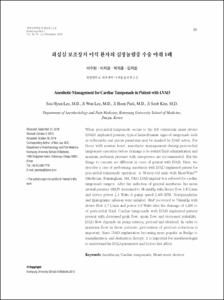좌심실 보조장치 이식 환자의 심장눌림증 수술 마취 1례
- Keimyung Author(s)
- Lee, Ji Won; Park, Ji Hoon; Kim, Ji Seob
- Journal Title
- Keimyung Medical Journal
- Issued Date
- 2019
- Volume
- 38
- Keyword
- Anesthesia; Cardiac tamponade; Heart-assist devices
- Abstract
- When pericardial tamponade occurs to the left ventricular assist device (LVAD) implanted patients, typical hemodynamic signs of tamponade such as tachycardia and pulsus paradoxus may be masked by LVAD action. For those with normal heart, anesthetic management during pericardial tamponade operation before drainage is to restrict fluid administration and maintain perfusion pressure with vasopressor are recommended. But the things to concern are different in cases of patient with LVAD. Here, we describe a case of performing anesthesia with LVAD implanted patient for pericardial tamponade operation. A 58-year-old male with HeartWare™ (Medtronic, Framingham, MA, USA) LVAD implant was referred for cardiac tamponade surgery. After the induction of general anesthesia, his mean arterial pressure (MAP) decreased to 38 mmHg with device flow 1.8 L/min and device power 2.4 Watts at pump speed 2,400 RPM. Norepinephrine and Epinephrine infusion were initiated. MAP recovered to 70mmHg with device flow 3.7 L/min and power 3.0 Watts after the drainage of 1,200 cc of pericardial fluid. Cardiac tamponade with LVAD implanted patient present with decreased peak flow, mean flow and decreased pulsatility. LVAD flow depends on pump rotation, preload and afterload. In order to maintain flow in these patients, prevention of preload reduction is important. Since LVAD implantation becoming more popular as Bridge to transplantation and destination therapy, it is important for anesthesiologist to understand the LVAD parameters and factors that affect.
- Alternative Title
- Anesthetic Management for Cardiac Tamponade in Patient with LVAD
- Publisher
- Keimyung University School of Medicine
- Citation
- 이수현 et al. (2019). 좌심실 보조장치 이식 환자의 심장눌림증 수술 마취 1례. Keimyung Medical Journal, 38, 51–55.
- Type
- Article
- Appears in Collections:
- 2. Keimyung Medical Journal (계명의대 학술지) > 2019
1. School of Medicine (의과대학) > Dept. of Anesthesiology & Pain Medicine (마취통증의학)
Items in Repository are protected by copyright, with all rights reserved, unless otherwise indicated.
